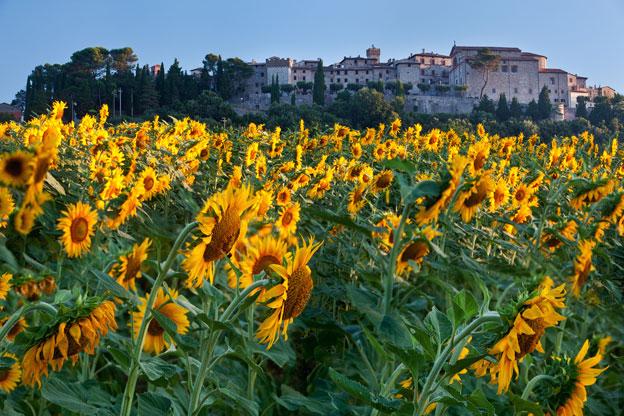For Everything There is a Season
ITA:

Use player to listen to Italian version
When I was just a child when my father told me, "If you have a plot of land you don't need to be afraid of anything: you can sow it with wheat and make bread to live on". He believed in the fertility of soil which abundantly rewards us with the fruits it produces in return for the hard work carried out in the fields. A whole life spent in daily sacrifice, nostalgia for times past and those important moments closely connected with the passing of the seasons and spent in harvesting, reaping, threshing, ploughing, the grape harvest and the myriad tasks necessary on the land is still alive in his memory and in the memory of others of his generation.
They all witnessed the introduction of machines that almost immediately took away the need for the manual labour they expended with care, passion and devotion in the fields. The flavour of the old customs and habits, however, and the values that these tasks have been able to generate, although faded with the passing of time, have traced a deep furrow in the course of farming civilisation. These indelible traces will remain alive forever, handed down from father to son. Like a storyteller, sitting down beside the big fireplace of our old country home, my father tells us of the most important moments of his past life when work was combined with cheerfulness, courage, unselfishness and generosity.
From morn till night
Harvest time used to start towards the end of June. Work began early in the morning and we went to the fields with sickles in hand and as soon as the previous night’s dew had evaporated from the crop, we reaped it. We stopped work during the hottest hours of the day, then started again, finishing up late into the evening.
When the harvest was over, the sheaves were transported by ox-drawn carts to the threshing-floor which had been immaculately cleaned for the event. We then proceeded to build ‘barche’ – big piles of wheat. July was threshing time: the threshing machine was hauled by oxen and moved from house to house. Mid morning we used to have lonza (a type of salame), wine and ciambellone (a large ring-shaped cake) for breakfast. The threshing machine never stopped, so we had to take our breaks in turn. During the day, someone was chosen to pass amongst the labourers at regular intervals, handing out water and wine.
A joyful sound
The greatest joy for the farmer was the sound of the siren. It sounded for only two reasons. The first was when the harvest weighed more than 10,000 kilos; this advised the neighbours that we had achieved the success so greatly longed for. We were so excited that we celebrated it by offering wine to everybody, or liqueurs if our finances ran to it. The second occasion was when we wanted the neighbouring farmer to know that threshing had ended and that the threshing machine would be moving to his threshing-floor the following day. At the end of the day we were all tired but the fatigue soon vanished when we all gathered around the table that had been laid outside for the occasion.
At last we had dinner and with great pleasure tucked into the dishes that were only cooked for special events. A few days before threshing commenced, the women prepared home-made bread, killed the fat- test cockerel for broth which was used to cook home-made pasta such as ‘quadretti’ or ‘passatelli’. Geese were seasoned with rosemary and sage whereas rabbits were flavoured with wild fennel; then garlic and a sprinkling of wine were added and all the poultry were put into big pots and roasted in a wood-fired oven. Large tomatoes and cucumber salads came directly from the kitchen gardens and roast potatoes completed the dinner. Bottles of red and white wine which came from the vineyard were arranged on the table at a regular distance one from the other.
And so the feast started.
Quando ero solo un bambino mio padre mi diceva, "Se hai un appezzamento di terra non devi temere nulla; puoi seminarlo a grano e poterci fare il pane per vivere". Credeva nella fertilità del terreno che abbondantemente ci ripaga con i frutti che produce in cambio del duro lavoro fatto nei campi. Una intera vita passata a sostenere sacrifici quotidiani, la nostalgia per i tempi andati e quei importanti momenti strettamente connessi con il trascorrere delle stagioni e passati a fare la mietitura, la raccolta, la selezione, l’aratura, la vendemmia e la miriade di adempimenti necessari in agricoltura è ancora vivo nella sua memoria e nella memoria degli altri della sua generazione.
Tutti loro sono stati testimoni dell’introduzione delle macchine che quasi subito hanno tolto la necessità del lavoro manuale col quale si prodigavano con cura, passione e devozione nei campi. Il sapore delle antiche tradizioni e consuetudini, tuttavia, e i valori che questi compiti erano in grado di generare, sebbene si siano affievoliti con il passare del tempo, hanno lasciato un solco profondo nello sviluppo della civiltà agricola. Queste tracce indelebili rimarranno vive per sempre, tramandate da padre in figlio. Come un narratore, seduto vicino al grande focolare della nostra vecchia casa di campagna, mio padre ci racconta dei più importanti momenti della loro vita passata quando il lavoro era accompagnato dalla contentezza, il coraggio, il non egoismo e la generosità.
Dalla mattina alla sera
Il tempo della raccolta usava iniziare verso la fine di Giugno. Il lavoro incominciava presto la mattina e andavamo nei campi con le falci in mano e non appena la rugiada della notte precedente era evaporata dalle piante, le raccoglievamo. Fermavamo il lavoro durante le ore più calde del giorno, poi incominciava di nuovo, ultimando tardi nella sera.
Quando la raccolta era finita, le spighe venivano trasportate da carri trainati da buoi al luogo della battitura che era stato pulito in modo immacolato per l’occasione. Procedevamo poi a costruire ‘barche’ – grandi mucchi di grano. Luglio era il tempo della trebbiatura: la macchina trebbiatrice trainata da buoi veniva portata da una casa all’altra. A metà mattina gustavamo per colazione la lonza (un tipo di salame), vino e ‘ciambellone’ (una torta a forma di grande anello).
Un suono gioioso
La gioia più grande per un coltivatore era il suono della sirena. Suonava solo per due ragioni. La prima era quando la raccolta pesava più di 10.000 chili; questo avvisava i vicini che avevamo raggiunto il successo da lungo tempo agognato. Eravamo così contenti che festeggiavamo offrendo vino a tutti, o liquori se le nostre finanze ce lo permettevano. La seconda occasione era quando volevamo fare sapere al nostro vicino agricoltore che la trebbiatura era terminata e che la macchina trebbiatrice si sarebbe spostata verso la sua aia per la trebbiatura il giorno successivo. Alla fine del giorno eravamo tutti stanchi ma la spossatezza svaniva presto quando ci radunavamo intorno alla tavola che era stata imbandita all’aria aperta per l’occasione.
Alla fine cenavamo e con grande piacere ci avventavamo sulle pietanze che venivano cucinate solo per eventi speciali. Un po’ di giorni prima che la trebbiatura cominciava, le donne preparavano il pane fatto in casa, uccidevano il gallo più grasso per il brodo che si usava per cucinare la pasta fatta in casa come i ‘quadretti’ o i ‘passatelli’. Le oche venivano marinate con rosmarino e salvia mentre i conigli venivano insaporiti con finocchio selvatico; poi l’aglio e una spruzzatina di vino venivano aggiunti e tutto il pollame veniva messo in grossi vasi e rosolato in un forno a legna. Grandi insalate a base di pomodori e cetrioli giungevano direttamente dai giardini della cucina e patate arrosto completavano la cena. Bottiglie di vino rosso e bianco che venivano dalla vigna erano sistemate sul tavolo ad una distanza regolare una dall’altra.
E così si dava inizio alla festa.











